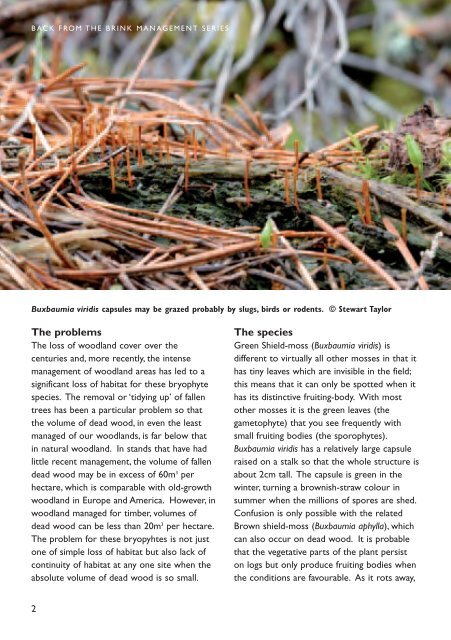Looking after Green Shield-moss (Buxbaumia viridis) and ... - Plantlife
Looking after Green Shield-moss (Buxbaumia viridis) and ... - Plantlife
Looking after Green Shield-moss (Buxbaumia viridis) and ... - Plantlife
You also want an ePaper? Increase the reach of your titles
YUMPU automatically turns print PDFs into web optimized ePapers that Google loves.
BACK FROM THE BRINK MANAGEMENT SERIES<br />
<strong>Buxbaumia</strong> <strong>viridis</strong> capsules may be grazed probably by slugs, birds or rodents. © Stewart Taylor<br />
The problems<br />
The loss of woodl<strong>and</strong> cover over the<br />
centuries <strong>and</strong>, more recently, the intense<br />
management of woodl<strong>and</strong> areas has led to a<br />
significant loss of habitat for these bryophyte<br />
species. The removal or ‘tidying up’ of fallen<br />
trees has been a particular problem so that<br />
the volume of dead wood, in even the least<br />
managed of our woodl<strong>and</strong>s, is far below that<br />
in natural woodl<strong>and</strong>. In st<strong>and</strong>s that have had<br />
little recent management, the volume of fallen<br />
dead wood may be in excess of 60m 3 per<br />
hectare, which is comparable with old-growth<br />
woodl<strong>and</strong> in Europe <strong>and</strong> America. However, in<br />
woodl<strong>and</strong> managed for timber, volumes of<br />
dead wood can be less than 20m 3 per hectare.<br />
The problem for these bryopyhtes is not just<br />
one of simple loss of habitat but also lack of<br />
continuity of habitat at any one site when the<br />
absolute volume of dead wood is so small.<br />
2<br />
The species<br />
<strong>Green</strong> <strong>Shield</strong>-<strong>moss</strong> (<strong>Buxbaumia</strong> <strong>viridis</strong>) is<br />
different to virtually all other <strong>moss</strong>es in that it<br />
has tiny leaves which are invisible in the field;<br />
this means that it can only be spotted when it<br />
has its distinctive fruiting-body. With most<br />
other <strong>moss</strong>es it is the green leaves (the<br />
gametophyte) that you see frequently with<br />
small fruiting bodies (the sporophytes).<br />
<strong>Buxbaumia</strong> <strong>viridis</strong> has a relatively large capsule<br />
raised on a stalk so that the whole structure is<br />
about 2cm tall. The capsule is green in the<br />
winter, turning a brownish-straw colour in<br />
summer when the millions of spores are shed.<br />
Confusion is only possible with the related<br />
Brown shield-<strong>moss</strong> (<strong>Buxbaumia</strong> aphylla), which<br />
can also occur on dead wood. It is probable<br />
that the vegetative parts of the plant persist<br />
on logs but only produce fruiting bodies when<br />
the conditions are favourable. As it rots away,

















